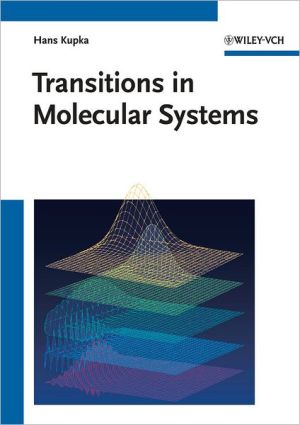

 |

|

Sold Out
Book Categories |
Preface.
1 Introduction.
1.1 The Adiabatic Description of Molecules.
1.2 Normal Coordinates and Duschinsky Effect.
1.3 The Vibrational Wavefunctions.
1.4 The Diabatic Electronic Basis for Molecular Systems.
2 Formal Decay Theory of Coupled Unstable States.
2.1 The Time Evolution of an Excited State.
2.2 The Choice of the Zero-Order Basis Set.
3 Description of Radiationless Processes in Statistical Large Molecules.
3.1 Evaluation of the Radiationless Transition Probability.
3.2 The Generating Function for Intramolecular Distributions I1 and I2.
3.3 Derivation of the Promoting Mode Factors Kg(t) and Ig(t).
3.4 Radiationless Decay Rates of Initially Selected Vibronic States in Polyatomic Molecules.
4 Calculational Methods for Intramolecular Distributions I1, I2, and IN.
4.1 The One-Dimensional Distribution I1(0, n; a, b).
4.2 The Distributions I1(m, n; a, b).
4.3 Calculation of the Multidimensional Distribution.
4.4 General Case of N-Coupled Modes.
4.5 Displaced Potential Surfaces.
4.6 The Contribution of Medium Modes.
5 The Nuclear Coordinate Dependence of Matrix Elements.
5.1 The q-Centroid Approximation.
5.2 Determination of the q-Centroid.
6 Time-Resolved Spectroscopy.
6.1 Formal Consideration.
6.2 Evaluation of the Radiative Decay Probability of a Prepared State.
6.3 The Sparse Intermediate Case.
6.4 Radiative Decay in Internal Conversion by Introduction of Decay Rates for {Ψ1}.
6.5 Dephasing and Relaxation in Molecular Systems.
7 Miscellaneous Applications.
7.1 The Line Shape Function for Radiative Transitions.
7.2 On the Mechanism of Singlet–Triplet Interaction.
7.3 Comment on the Temperature Dependence of Radiationless Transition.
7.4 Effect of Deuteration on the Lifetimes of Electronic Excited States.
7.5 Theory and Experiment of Singlet Excitation Energy Transfer in Mixed Molecular Crystals.
7.6 Electronic Predissociation of the 2B2 State of H2O+.
8 Multidimensional Franck–Condon Factor.
8.1 Multidimensional Franck–Condon Factors and Duschinsky Mixing Effects.
8.2 Recursion Relations.
8.3 Some Numerical Results and Discussion.
8.4 Implementation of Theory and Results.
8.5 The One-Dimensional Franck–Condon Factor (N = 1)
Appendices.
Appendix A: Some Identities Related to Green.s Function.
A.1 The Green.s Function Technique.
A.2 Evaluation of the Diagonal Matrix Element of Gss.
Appendix B: The Coefficients of the Recurrence Equation.
Appendix C: The Coefficients of the Recurrence Equations.
Appendix D: Solution of a Class of Integrals.
Appendix E: Quantization of the Radiation Field.
Appendix F: The Molecular Eigenstates.
Appendix G: The Effective Hamiltonian and Its Properties.
Appendix H: The Mechanism of Nonradiative Energy Transfer.
Appendix I: Evaluation of the Coefficients bmn, cmn, and bm in the Recurrence Equations 8.28 and 8.29.
Appendix J: Evaluation of the Position Expectation Values of xsm(qs).
Appendix K: Vibronic Coupling Between Two Electronic States: The Pseudo-Jahn–Teller Effect.
References.
Index.
Login|Complaints|Blog|Games|Digital Media|Souls|Obituary|Contact Us|FAQ
CAN'T FIND WHAT YOU'RE LOOKING FOR? CLICK HERE!!! X
 You must be logged in to add to WishlistX
 This item is in your Wish ListX
 This item is in your CollectionTransitions in Molecular Systems
X
 This Item is in Your InventoryTransitions in Molecular Systems
X
 You must be logged in to review the productsX
 X
 X

Add Transitions in Molecular Systems, Filling the gap for a book covering vibronic, nonadiabatic and diabatic couplings as well as radiationless processes in context, this monograph compiles classic and cutting-edge work from numerous researchers into one handy source. Alongside a descrip, Transitions in Molecular Systems to the inventory that you are selling on WonderClubX
 X

Add Transitions in Molecular Systems, Filling the gap for a book covering vibronic, nonadiabatic and diabatic couplings as well as radiationless processes in context, this monograph compiles classic and cutting-edge work from numerous researchers into one handy source. Alongside a descrip, Transitions in Molecular Systems to your collection on WonderClub |